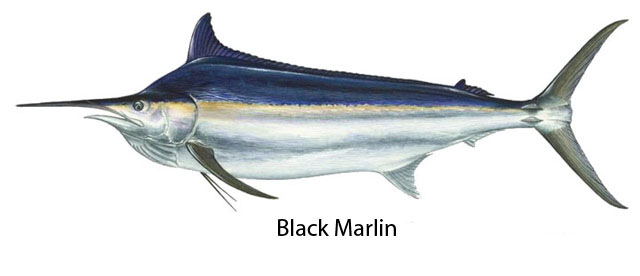
BLACK MARLIN

Makaira indica
Spanish: Marlin Negro.
Found in tropical and subtropical Indo-Pacific oceans not far from the surface.
The black marlin is the only marlin, regardless of size, whose pectoral fins are rigid and cannot be folded flat up against the body without breaking the joints. The pectoral fins also have an airfoil shape, whereas those of other marlin are flat. The ventral fins are extremely short, almost never exceeding 12 inches in length. The first dorsal fin is retractable and fits into a groove along the back; it is proportionately the lowest of any billfish, usually less than 50 percent of the body depth. The leading edge of the second dorsal fin sits slightly in front of the second anal fin. The lateral line, which is rarely visible in adults, is a straight double row of pores.
Its body is laterally compressed, rather than rounded - much more so than in the similar-size blue marlin, and the upper jaw is elongated in the form of a spear. Dorsally, the body is a dark slate blue, but this coloring changes suddenly to a silvery white below the lateral line. Light-blue body stripes are usually visible on live marlin, especially when the fish is excited; these fade after death. Slight variations in color cause some specimens to have a silvery haze over the body. In Hawaii this has led to the name "silver marlin" (once thought to be a separate species). The name "white marlin," applied in Japan, refers to the color of the meat rather than the external color of the fish, and should not be confused with the white marlin species.
Very strong and exceptionally fast, black marlin feed on squid and pelagic fishes including tuna and dolphin. Along with their cousins the striped marlin, they spawn in the Northern Pacific from May to August. Blacks exceeding 300 pounds are almost always females.
A highly rated game fish, the black marlin has the power, size, and persistence of which anglers dream. Black marlin tend to swim deeply, without jumping, when hooked, but can make spectacular jumps early in the battle. Fishing methods include trolling with large, whole baits or with artificial lures. Live bait is also effective.
World Record:
1,560 pounds (Cabo Blanco, Peru); 1,439 pounds (Cairns, Australia).